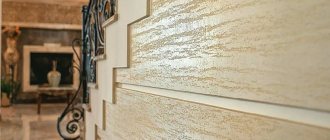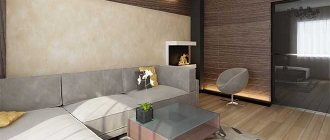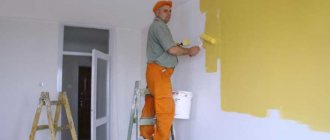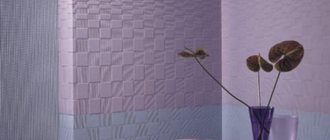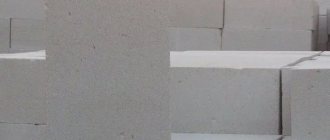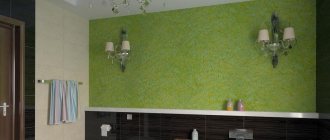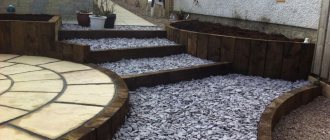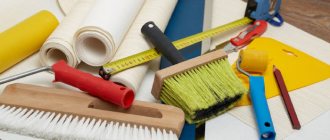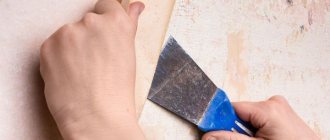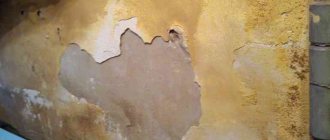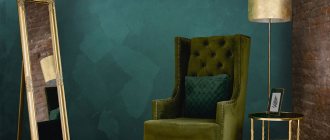Modern construction technologies provide a diverse selection of materials for finishing and surface treatment of walls. You can simply stick on traditional paper rolls, or you can pay attention to special wallpaper for painting. Or decide on a more modern and interesting design in the form of decorative plaster.
Vinyl wallpapers
What's better? What to give preference to? In order to decide on the choice of material, you need to understand the principle of its use, as well as the pros and cons.
Wallpaper for painting
This type of wall decoration is popular. The main advantage is that if the paint has faded or become boring, you can simply repaint it.
The material for painting can be of the following varieties:
- paper;
- non-woven;
- glass wallpaper.
Wallpaper for painting
The non-woven covering is easier to paint and is less susceptible to moisture and the appearance of fungi.
Minuses:
- Paper and non-woven rolls, like regular ones, cause difficulties when gluing to walls. They can become deformed, stretch and bubble.
- Only glass wallpaper can eliminate defects in the wall surface. However, they cost a lot.
- The number of new stains is limited to 5-7 times.
- May peel off in rooms with high humidity.
Liquid wallpaper
Fundamentally excellent material. It is a dry mixture containing the following ingredients:
- adhesive composition;
- dyes;
- cellulose and cotton fibers.
Before use, the composition is diluted with water and then evenly applied to the walls. In addition to ease of use, other advantages of the material can be noted:
- absence of joints, which are inevitable when using paper rolls;
- static and fire resistance;
- high environmental friendliness.
But there are also disadvantages:
- If liquid wallpaper is planned in the bathroom or kitchen, you will also have to apply a layer of colorless varnish on top of it. This will cause the material to lose its original positive breathability.
- A heavily contaminated area can be torn off the wall and a fresh layer can be rolled in its place. But it is possible that the new mixture will differ in color from the old one, especially if there was a lot of smoking or a stove in the room. It is because of the difficulties in care that this species often receives negative reviews from people.
General advantages and disadvantages
In order to understand what is best to use as a wall covering material, you should consider the advantages and disadvantages of finishing. For example, wallpaper is natural if it is made entirely of paper. But this coating has a fairly short service life. Canvases will last much longer if they are made of vinyl or non-woven fabric. The first type of wallpaper is different:
- strength;
- durability;
- moisture resistance;
- versatility.
But such decorative finishing also has its drawbacks. They are airtight and unsuitable for repair. In addition, vinyl sheets are quite expensive in cost.
Decorative finishing of the walls of the house can also be done using non-woven wallpaper. They are offered for sale in a wide range of textures and colors, are not at all afraid of water and are impregnated with special agents that prevent the formation of fungus and mold.
After completing renovations in a room whose walls were covered with non-woven wallpaper, you may encounter a not very favorable microclimate, since the canvases do not allow air to pass through well. They may contain harmful substances, so non-woven covering is not recommended for gluing in bedrooms and children's rooms.
When deciding which is better - liquid wallpaper or decorative plaster, you should consider the latter option in more detail, paying attention to the advantages and disadvantages. The advantages of plaster are:
- environmental friendliness;
- ease of mixing the solution;
- durability;
- unpretentiousness in care and maintenance;
- wide range of colors and textures.
But decorative plaster also has its disadvantages. One of the main ones is the difficulty of application. If the owner of an apartment or house does not have the appropriate skills, he will have to use the expensive services of professionals. It is necessary to take into account not only the operational characteristics, but also the complexity of dismantling if it is necessary to change the coating.
If the consumer cannot decide which is better to choose - plaster mixture or wallpaper, he most often pays attention to the liquid variety of the latter. Among their advantages are the absence of dust during application, the elasticity of the surface and a simpler application algorithm.
But plaster beats wallpaper in terms of decorativeness. The first option offers the consumer a wider variety of reliefs, textures and colors. In addition, the service life of liquid wallpaper may be shorter compared to plaster. After applying liquid wallpaper, the surface turns out to be structured, and with the help of such a composition it is more difficult to create the desired texture.
Decorative plaster
If you want to make a good renovation, you should take a more serious approach to the choice of wall decoration. Even if the consumer likes decorative plaster in appearance, he should become more familiar with the advantages and disadvantages of this coating. It is also good because it can act as thermal insulation. Plaster is universal, so it can be used for any interior style. It is completely safe, which means it cannot harm human health.
This composition is also offered for sale in a vandal-proof version, which is well suited for those consumers who have children and pets in the house. Only rare types of wallpaper can boast of such properties, and even then, they are able to undergo mechanical stress only when it is not too intense.
Plaster, even without anti-vandal characteristics, is durable. It exhibits the ability to endure changes in temperature and humidity. The coating does not require special care, does not fade in the sun, and even over time retains its original attractive appearance.
When the consumer is put off by the high cost, he should think about whether it is justified by the quality and long service life. With the help of such decorative compositions, you can create your own design, making the room truly unique.
Attention! Before purchasing decorative plaster to decorate the walls of one of the rooms of your home, you should take into account that this material is quite difficult to apply, and you are unlikely to be able to cope with this task on your own.
Liquid wallpaper
Liquid wallpaper is good because it can level out minor unevenness in the walls, which means you don’t need to prepare the surface particularly carefully. Walls after such cladding acquire the quality of noise reduction and frost resistance. The coating is repairable and lightfast. But its high-quality variety has a high cost and takes a long time to dry after application.
Attention! The wall after such repairs is not resistant to moisture unless the surface is coated with a special compound.
Dry plaster
The next type is gypsum sheets with cardboard covering. A popular material when working with ceilings. Has a number of advantages:
- no odor;
- sound and heat insulation;
- hiding wall defects;
- additional opportunity for laying communications (between the cardboard surface and dry gypsum sheets).
However, there remains a significant disadvantage in that you still need to glue wallpaper on top of the cardboard.
Decorative plaster
Decorative plaster is a viscous mass of natural and synthetic elements and grains of different sizes. Basically, it is the grains that give the wall an unusual but stylish look (as shown in the photo).
The structure of the material itself allows you to create more and more new design solutions. Plaster comes in the following types:
- textured with relief, imitating brickwork, stone wall, etc.;
- smooth Venetian, with a pattern, popular when creating a marble wall;
- flocks that reproduce the effect of wet silk, velor or velvet, and much more.
Applying decorative plaster does not require special knowledge or specific tools. The only disadvantage of the material is its relative high cost. But this mainly concerns the services of a designer invited to create an individual drawing. Otherwise there are significant advantages:
- ease of cleaning from dirt with any detergents, including abrasives;
- absolute resistance to physical damage;
- fire safety;
- moisture resistance;
- hiding wall defects;
- durability.
Another interesting feature of plaster. We are talking about its ability to divide space into zones. This is achieved by using different colors and decor, using panels and other techniques.
What to choose?
All of the listed materials are divided into different types of wallpaper and decorative plaster. Second, according to numerous reviews, it is truly impossible to damage or scratch. At the same time, it looks stylish, rich and modern.
Even wallpaper with decorative plaster only imitates the material in appearance, but does not have convincing advantages. Decorative plaster is easy to clean, model, and renew. She is not afraid of fire and humidity. The chosen color and design can be preserved for decades without losing structure and color.
Plaster solutions
Decorative plaster is used for final finishing of walls. It contains special substances - fillers. With their help, a beautiful drawing is created. Using this material, the following effects are created: aging; cracking; cracks that add volume; roughness; silkiness; different relief depths.
Plaster can be purchased ready-made. The mixture is pre-diluted with solvents or water. When repairing, it is used immediately. Dry mixtures require the addition of liquid according to the instructions. To achieve the desired effect, additional fillers are added to the solution - shells, small stones.
Kinds
When choosing plaster, the following features are taken into account: room humidity, general interior. The composition divides the material into the following types:
- Acrylic. Sold as a solution. Elasticity allows application to different surfaces. It is resistant to moisture, steam, temperature changes, and ultraviolet rays. It is easy to maintain and resistant to abrasive cleaning agents. Long service life. Disadvantages: low fire resistance and loss of appearance over time.
- Mineral. The dry cement mixture is diluted with water in the required volume. Advantages: strength, moisture resistance, high vapor permeability, thermal insulation. To improve the appearance, painting or varnishing is required.
- Silicate. The basis is liquid glass with mineral additives. Rarely used for interior spaces. Advantages: elasticity, strength, vapor permeability, moisture resistance, mold resistance. The advantages include ease of care and durability. Fast drying requires a high rate of application. A serious drawback is the lack of environmental friendliness and the possibility of harm to health.
- Silicone. Made from silicone resins and fillers. Sold in diluted form, in various colors. Elastic, moisture-resistant, vapor-permeable, durable.
- Silk. Includes fiber particles of natural silk, thereby achieving a decorative effect.
The dry mixture should be diluted in small portions, since the solution thickens quickly.
Texture
Depending on the fillers that create the desired effect, plaster is divided into the following types:
- Textured. Fillers - mica, wood, pebbles, sand, marble and granite chips. The material is waterproof, has heat and sound insulation properties. Imitation of other materials is possible: leather, wood, stone.
- Structural. Sold ready-made. Fillers - quartz and marble chips. The coating is resistant to mechanical stress, breathable, and moisture resistant.
- Venetian. Guaranteed beautiful coverage. The finished mixture contains tiny pieces of marble, malachite and granite. Adding color dyes will provide a decent appearance. To protect the surface, varnish or wax is applied on top. The coating is environmentally friendly, fireproof, resistant to moisture and wear.
- Flock. The composition includes acrylic flakes - flocks. They imitate various materials.
- "Bark beetle." There are several components in the mixture. The majority are mineral granules that create a pattern reminiscent of the passages of a bark beetle. Dry and diluted mixtures are available for sale.
- "Lamb." The basis is cement. Additives - dolomite, quartz, marble. The addition of additives provides UV resistance.
- "Fur coat". A cheap and popular option. Dry mixtures and ready-made solutions are available for sale.
The choice of type of plaster is determined by the surrounding interior, available finances and personal preferences.
Advantages of decorative plaster
The advantages of this material are as follows:
- no seams;
- protection from extraneous noise;
- moisture resistance;
- resistance to temperature changes;
- smoothing out irregularities;
- plastic;
- ease of application;
- unpretentious operation;
- ease of care;
- variety of colors.
The ability to imitate stone coverings is also important.
